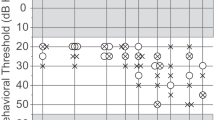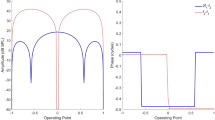Abstract
Previous research on distortion product otoacoustic emission (DPOAE) components has hinted at possible differences in the effect of aging on the two basic types of OAEs: those generated by a reflection mechanism in the cochlea and those created by nonlinear distortion (Abdala and Dhar in J Assoc Res Otolaryngol 13:403–421, 2012). This initial work led to the hypothesis that micromechanical irregularity (“roughness”) increases in the aging cochlea, perhaps as the result of natural tissue degradation. Increased roughness would boost the backscattering of traveling waves (i.e., reflection emissions) while minimally impacting DPOAEs. To study the relational effect of aging on both types of emissions and address our hypothesis of its origin, we measured reflection- and distortion-type OAEs in 77 human subjects aged 18–76 years. The stimulus-frequency OAE (SFOAE), a reflection emission, and the distortion component of the DPOAE, a nonlinear distortion emission, were recorded at multiple stimulus levels across a four-octave range in all ears. Although the levels of both OAE types decreased with age, the rate of decline in OAE level was consistently greater for DPOAEs than for SFOAEs; that is, SFOAEs are relatively preserved with advancing age. Multiple regression analyses and other controls indicate that aging per se, and not hearing loss, drives this effect. Furthermore, SFOAE generation was simulated using computational modeling to explore the origin of this result. Increasing the amount of mechanical irregularity with age produced an enhancement of SFOAE levels, providing support for the hypothesis that increased intra-cochlear roughness during aging may preserve SFOAE levels. The characteristic aging effect—relatively preserved reflection-emission levels combined with more markedly reduced distortion-emission levels—indicates that SFOAE magnitudes in elderly individuals depend on more than simply the gain of the cochlear amplifier. This relative pattern of OAE decline with age may provide a diagnostic marker for aging-related changes in the cochlea.












Similar content being viewed by others
References
Abdala C, Dhar S (2010) Distortion product otoacoustic emission phase and component analysis in human newborns. J Acoust Soc Am 127:316–325
Abdala C, Dhar S (2012) Maturation and aging of the human cochlea: A view through the DPOAE looking glass. J Assoc Res Otolaryngol 13:403–421
Abdala C, Kalluri R (2017) Towards a joint reflection-distortion otoacoustic emission profile: results in normal and impaired ears. J Acoust Soc Am 142:812–824
Abdala C, Mishra SK, Williams TL (2009) Considering distortion product otoacoustic emission fine structure in measurements of the medial olivocochlear reflex. J Acoust Soc Am 125:1584–1594
Abdala C, Luo P, Shera CA (2015) Optimizing swept-tones to measure DPOAEs in adult and newborn ears. J Acoust Soc Am 138:3785–3799
Abdala C, Luo P, Shera CA (2016) Comparison of methods for DPOAE component separation. Poster presented to the 39th midwinter meeting of the Association for Research in Otolaryngology, San Diego, CA
Abdala C, Guardia Y, Luo P, Shera CA (2018) Swept-tone stimulus frequency otoacoustic emissions: Normative data and methodological considerations. J Acoust Soc Am 143:181–192
Bhatt K, Liberman MC, Nadol JB Jr (2001) Morphometric analysis of age-related changes in the human basilar membrane. Ann Otol Rhinol Laryngol 110:1147–1153
Burns EM (2009) Long-term stability of spontaneous otoacoustic emissions. J Acoust Soc Am 125:3166–3176
Burns EM (2017) Even longer term stability of spontaneous otoacoustic emissions. J Acoust Soc Am 142:1828–1831
Castor X, Veuillet E, Morgon A, Collet L (1994) Influence of aging on active cochlear micromechanical properties and on the medial olivocochlear system in humans. Hear Res 77:1–8
Cheatham M, Ahmad A, Zhou A, Goodyear Y, Dallos P, Richardson J (2016) Increased spontaneous otoacoustic emissions in mice with a detached tectorial membrane. J Acoust Soc Am 17:81–88
Deeter R, Abel R, Calandruccio L, Dhar S (2009) Contralateral acoustic stimulation alters the magnitude and phase of distortion product otoacoustic emissions. J Acoust Soc Am 126:2413–2424
Dong W, Olson ES (2010) Local cochlear damage reduces local nonlinearity and decreases generator-type cochlear emissions while increasing reflector-type emissions. J Acoust Soc Am 127:1422–1431
Dorn PA, Piskorski P, Keefe DH, Neely ST, Gorga MP (1998) On the existence of an age/threshold/frequency interaction in distortion product otoacoustic emissions. J Acoust Soc Am 104:964–971
Fitzgibbons PJ, Gordon-Salant S (2010) Behavioral studies with aging humans: Hearing sensitivity and psychoacoustics. In: Gordon-Salant S, Frisina RD, Fay RR, Popper AN (eds) The aging auditory system. Springer, New York, pp 111–134
Gorga MP, Neely ST, Bergman B, Beauchaine KL, Kaminski JR, Peters J, Jesteadt W (1993) Otoacoustic emissions from normal-hearing and hearing-impaired subjects: Distortion product responses. J Acoust Soc Am 93:2050–2060
Gorga MP, Neely ST, Ohlrich B, Hoover B, Redner J, Peters J (1997) From laboratory to clinic: A large-scale study of distortion product otoacoustic emissions in ears with normal hearing and ears with hearing loss. Ear Hear 18:440–455
Greenwood DD (1990) A cochlear frequency-position function for several species—29 years later. J Acoust Soc Am 87:2592–2605
Hopkins K, Moore BC (2011) The effects of age and cochlear hearing loss on temporal fine structure sensitivity, frequency selectivity, and speech reception in noise. J Acoust Soc Am 130:334–349
Hoth S, Gudmundsdottir K, Plinkert P (2010) Age dependence of otoacoustic emissions: the loss of amplitude is primarily caused by age-related hearing loss and not by aging alone. Eur Arch Otoryhinolaryngol 267:679–690
Kalluri R, Shera CA (2013) Measuring stimulus-frequency otoacoustic emissions using swept-tones. J Acoust Soc Am 134:356–368
Konrad-Martin D, Keefe DH (2005) Transient-evoked stimulus-frequency and distortion-product otoacoustic emissions in normal and impaired ears. J Acoust Soc Am 117:3799–3815
Kummer P, Janssen T, Hulin P, Arnold W (1998) The level and growth behavior of the 2f 1–f 2 distortion product otoacoustic emission and its relationship to auditory sensitivity in normal hearing and cochlear hearing loss. J Acoust Soc Am 103:3431–3444
Lapsley-Miller JA, Marshall L, Heller LM (2004) A longitudinal study of changes in evoked otoacoustic emissions and pure-tone thresholds as measured in a hearing conservation program. Int J Audiol 43:307–322
Lee J, Dhar S, Abel R, Banakis R, Grolley E, Lee J, Zecker S, Siegel J (2012) Behavioral hearing thresholds between 0.125 and 20 kHz using depth-compensated ear simulator calibration. Ear Hear 33:315–329
Long GR, Talmadge CL, Lee J (2008) Measuring distortion product otoacoustic emissions using continuously sweeping primaries. J Acoust Soc Am 124:1613–1626
Lonsbury-Martin BL, Cutler WM, Martin GK (1991) Evidence for the influence of aging on distortion-product otoacoustic emissions in humans. J Acoust Soc Am 89:1749–1759
Mishra SK, Biswal M (2016) Time–frequency decomposition of click evoked otoacoustic emissions in children. Hear Res 335:161–178
Moleti A, Longo F, Sisto R (2012) Time-frequency domain filtering of evoked otoacoustic emissions. J Acoust Soc Am 132:2455–2467
Morrell CH, Gordon-Salant S, Pearson JD, Brant LJ, Fozard JL (1996) Age- and gender-specific reference ranges for hearing level and longitudinal changes in hearing level. J Acoust Soc Am 100:1949–1967
Ortmann AJ, Abdala C (2016) Changes in the compressive nonlinearity of the cochlea during early aging: estimates from distortion OAE input/output functions. Ear Hear 37:603–614
Ortmann AJ, Guardia YC, Abdala C (2017) Aging and cochlear nonlinearity as measured with distortion OAEs and loudness perception. Poster presented to the 40th Annual Midwinter Meeting of the Assoc Res Otolaryngol, Baltimore, MD
Poling GL, Siegel JH, Lee J, Lee J, Dhar S (2014) Characteristics of the 2f(1)–f(2) distortion product otoacoustic emission in a normal hearing population. J Acoust Soc Am 135:287–299
Rao A, Long GR (2011) Effects of aspirin on distortion product fine structure: interpreted by the two-source model for distortion product otoacoustic emissions generation. J Acoust Soc Am 129:792–800
Satoh Y, Kanzaki J, O-Uchi T, Yoshihara S (1998) Age-related changes in transiently evoked otoacoustic emissions and distortion product otoacoustic emissions in normal-hearing ears. Auris Nasus Larynx 25:121–130
Schairer KS, Fitzpatrick DH, Keefe DH (2003) Input–output functions for stimulus-frequency otoacoustic emissions in normal-hearing adult ears. J Acoust Soc Am 114:944–966
Shera CA (2003) Mammalian spontaneous otoacoustic emissions are amplitude-stabilized cochlear standing waves. J Acoust Soc Am 114:244–262
Shera CA, Bergevin C (2012) Obtaining reliable phase-gradient delays from otoacoustic emissions data. J Acoust Soc Am 132:927–943
Shera CA, Guinan JJ (1999) Evoked otoacoustic emissions arise by two fundamentally different mechanisms: A taxonomy for mammalian OAEs. J Acoust Soc Am 105:782–798
Shera CA, Guinan JJ (2003) Stimulus-frequency-emission group delay: A test of coherent reflection filtering and a window on cochlear tuning. J Acoust Soc Am 113:2762–2772
Shera CA, Guinan JJ, Oxenham AJ (2002) Revised estimates of human cochlear tuning from otoacoustic and behavioral measurements. Proc Natl Acad Sci U S A 99:3318–2232
Shera CA, Tubis A, Talmadge CL (2005) Coherent reflection in a two-dimensional cochlea: Short-wave versus long-wave scattering in the generation of reflection-source otoacoustic emissions. J Acoust Soc Am 118:287–313
Shera CA, Tubis A, Talmadge CL (2008) Testing coherent reflection in chinchilla: Auditory-nerve responses predict stimulus-frequency emissions. J Acoust Soc Am 124:381–395
Shera CA, Guinan JJ, Oxenham AJ (2010) Otoacoustic estimation of cochlear tuning: Validation in the chinchilla. J Assoc Res Otolaryngol 11:343–365
Stover L, Norton S (1993) The effects of aging on otoacoustic emissions. J Acoust Soc Am 94:2670–2681
Talmadge CL, Tubis A, Long GR, Tong C (2000) Modeling the combined effects of basilar membrane nonlinearity and roughness on stimulus frequency otoacoustic emission fine structure. J Acoust Soc Am 108:2911–2932
Uchida Y, Ando F, Shimokata H, Sugiura S, Ueda H, Nakashima T (2008) The effects of aging on distortion-product otoacoustic emissions in adults with normal hearing. Ear Hear 29:176–184
Whitehead ML, Stagner BB, Martin GK, Lonsbury-Martin BL (1996) Visualization of the onset of distortion-product otoacoustic emissions, and measurement of their latency. J Acoust Soc Am 100:1663–1679
Zweig G, Shera CA (1995) The origin of periodicity in the spectrum of evoked otoacoustic emissions. J Acoust Soc Am 98:2018–2047
Acknowledgements
Supported by NIH/NIDCD Grants R01 DC003552 (C.A.) and R01 DC003687 (C.A.S.). We are grateful to Yeini Guardia for assistance in data collection and management and to Ping Luo for assistance in data analysis.
Author information
Authors and Affiliations
Corresponding author
Ethics declarations
Conflict of Interest Statement
None of the authors of this research study have a commercial interest in this work nor other conflicts of interest.
Rights and permissions
About this article
Cite this article
Abdala, C., Ortmann, A.J. & Shera, C.A. Reflection- and Distortion-Source Otoacoustic Emissions: Evidence for Increased Irregularity in the Human Cochlea During Aging. JARO 19, 493–510 (2018). https://doi.org/10.1007/s10162-018-0680-x
Received:
Accepted:
Published:
Issue Date:
DOI: https://doi.org/10.1007/s10162-018-0680-x




